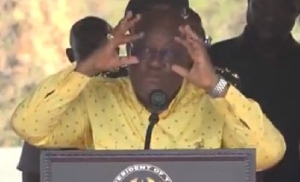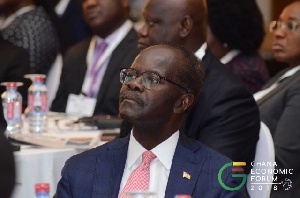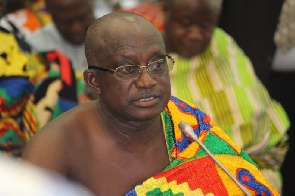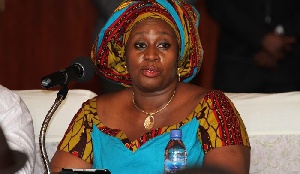 The Ghana Statistical Service (GSS)
The Ghana Statistical Service (GSS)
The latest data from the Ghana Statistical Service, released last week, confirms the widely anticipated fact that the national economy exited its first recession in some four decades during the last quarter of 2020.
The economy grew by 0.4 percent for the full year in 2020, gathering steam in the last three months after contractions in the second and third quarters due to the coronavirus outbreak.
Ghana’s gross domestic product grew 3.3% year-on-year in the fourth quarter as economic activities picked up following the easing of COVID-19 restrictions. However the GSS revised the contractions it had computed on provisional basis in the second quarter to 5.9 percent, up from 3.2% previously, and for the third quarter to 3.2 percent, up from 1.1% as originally pronounced last year.
Conversely the statistics office revised the first quarter 2020 gross domestic product upwards to 6.8% from 4.9% previously computed. The overall result of the revisions and the computations for the last quarter of the year resulted in full year economic growth that is disappointing in that it is less than half the revised growth rate of 0.9 percent anticipated by the Ministry of Finance in its mid 2020 budget review which took into account the expected effects of the COVID 19 outbreak on the economy.
Indeed the Bank of Ghana had been even more optimistic announcing a revised full year forecast of between 2.0 percent and 2.5 percent in late 2020, before revising it downward again after receiving disappointing third quarter growth data.
Agriculture activity expanded significantly to 8.2 percent for the last quarter of 2020 up from 4.9% percent in the third quarter, mainly driven by output increases in crops & cocoa whose growth rose to 10.6percent from 5.2 percent in the previous quarter.
In addition, services rebounded from two consecutive quarters of contraction to reach 4.6 percent from negative growth of -3.3 in the preceding quarter, boosted by trade; repair of vehicles, household goods (5.5 percent vs -11.4 percent) and in real estate (43.5 percent vs -6.6 percent).
Furthermore, output in the industrial sector declined at a much slower pace of -0.4 percent from -7.2 percent in the 3rd quarter, a trend also recorded in mining (-10.9 percent vs -12.4 percent), and in oil & gas (-9.8 percent vs -10.8 percent).
The International Monetary Fund agrees with government that a sharp economy is recovery on the cards in 2021. It forecasts full-year growth of 4.6 percent – higher than its 3.3 percent forecast for sub-Saharan Africa as a whole – but even this is 400 basis points short of government’s own target of 5.0 percent.
Ghana will also draw solace from the fact that its non-oil economy y grew by 1.3 percent in 2020, more than three times the oil-inclusive full economy growth rate. Indeed this means that Ghana’s economic growth for 2020 was pulled back by the slump in crude oil prices which fell to a long term low as COVID 19 killed global demand for energy.
Crude oil is Ghana’s third largest foreign exchange earner after gold and cocoa. However global crude oil prices have recovered since reaching a trough of barely US$20 a barrel during 2020, and the Brent brand, which is similar in texture and price to Ghana’s Jubilee brand is now trading at close to US$70 a barrel which is near pre-COVID 19 levels.
The growth forecast for 2021 has been full of controversy, with both the World Bank and the International Monetary Fund having upgraded their initial dismal forecasts of less than 2 percent upwards after realizing that Ghana’s second wave of COVID 19 is not as bad as the western hemisphere’s and that the Ghana CARES initiative has the potential to combine direly needed fiscal consolidation with strong growth, and now the general consensus is that Ghana can achieve over 4 percent growth although that consensus still falls short of government’s 5.0 percent target for 2021.
Fitch, whose forecasts largely guide the international investment community and so are influential in driving the country’s debt refinancing efforts, predicts that Ghana will experience a buoyant economic growth in the second half of this year due to increase aggregate demand and up-tick in private consumption.
This will offset the relatively slow economic growth anticipated during the first half of this year it projects. According to Fitch Solutions, research arm of ratings agency, Fitch, Ghana’s economy will grow at a rate of 4.6% Gross Domestic Product (GDP) – same as the International Monetary Fund forecast.
It also said investments will rise, better than last year, but will not significantly impact on the growth rate.
Speaking on its April 2021 Sub Saharan Africa Update, Senior Country Risk Analyst at Fitch Solutions Sub Saharan Africa team, William Attwell, said Ghana is set to remain a regional outperformer in 2021, and Fitch Solutions forecast that real GDP growth will accelerate to 4.5% in 2021.
He pointed out that “growth will increase considerably, following last year’s slump and we expect it to be driven mainly by an up-tick in private consumption. As labour market conditions improve and inflation moderates somewhat, export will also perform well as global demand for commodities such as cocoa and oil rises.”
“Ghana is outperforming other West African markets in terms of the vaccine [covid-19 vaccine] rollout. It is still actually very slow and small scale, and as we expect some social distancing measures to remain in place in the coming months which will of course weigh on confidence and business activities certainly in the first half of the year”, he emphasized.
“But achieving the highest number of vaccinations per 100 people among SSA’s main markets so far, with 2.3% of the population having received their first vaccine dose as of April 11 (latest available data). If this rate of vaccinations is maintained, this will likely lead to an earlier easing of lockdown restrictions compared to most regional peers, and a quicker recovery in consumer spending and business activity”, he further said.
Ghana was however among few countries on the African continent that recorded positive growth rates in 2020 in a year that covid-19 impacted negatively on global economies.
The services sector is the largest sector of the Ghanaian economy, accounting for 52 percent of the GDP. Within services, the most important sub-sectors are: transport and storage (10 percent); information and communication (9.8 percent); trade, repair of vehicles and household goods (7 percent) and financial and insurance activities; education and public administration & defense and social security (4 percent each).
Also, industry accounts for 26 percent of the GDP with mining and quarrying (10 percent); construction (8 percent) and manufacturing (7 percent). Agriculture accounts for 22 percent, mainly crops (17 percent). On the expenditure side, household consumption is the main component of the GDP and accounts for 81 percent of its total use, followed by gross fixed capital formation (11 percent); government expenditure (10 percent) and changes in stocks (2 percent). Exports of goods and services account for 48 percent of GDP while import accounts for 52 percent.
- BoG, finance ministry to sign MoU on central bank recapitalization – Dr. Addison
- 'Togolese workers more productive than Ghanaian workers' – Prof. Stephen Adei
- Third tranche US$360 million will further boost Ghana's reserve – Dr. Addison
- March's 25.8% inflation rate poses no threat to disinflation trend – Analyst
- Soy, corn price stability to drive local poultry market
- Read all related articles












